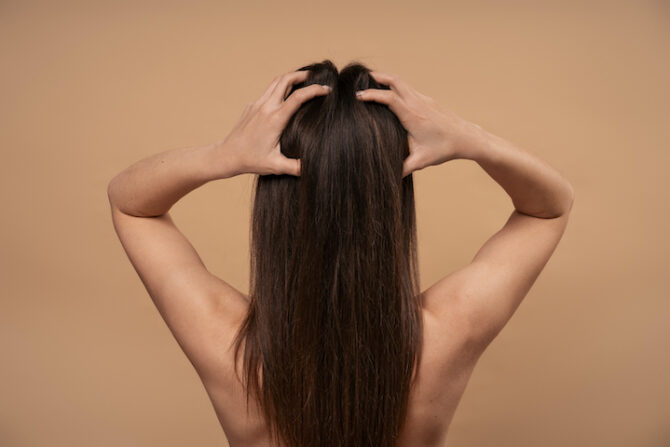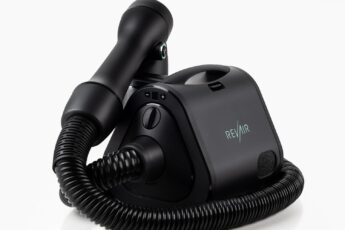You know that sharp sting you sometimes feel when you run your fingers through your hair? Then, when you look closer, you see a tiny bump hiding under your strands. That’s scalp acne — quiet at first, but it can turn painful fast.
I remember thinking mine was just a random irritation from a tight bun. But then, days later, the bumps were still there, and I started feeling that itchy, tender patch near my crown. That was when I learned how common scalp acne really is.
If you’ve been there, you know how uncomfortable it gets. The itching, the tenderness, even that greasy feeling you can’t shake off — it’s a lot. But here’s the good news: scalp acne treatment doesn’t have to be complicated or harsh. With a gentle routine and the right products, your scalp can heal. And once it does, your hair feels lighter, cleaner, and much more alive.
Table of Contents
Key Takeaways
- Scalp acne is common and completely treatable.
- Gentle care and consistency work better than harsh treatments.
- Medicated shampoos, scalp scrubs, and leave-in treatments help clear buildup and soothe irritation.
- Listen to your scalp — it always tells you what it needs.
Understanding Scalp Acne
Scalp acne isn’t so different from facial acne — it’s just hiding beneath your hair. It happens when oil, sweat, and dead skin cells clog your pores. The result? Those small, sore bumps that sometimes even turn into pustules or cysts.
You might be wondering, “Why my scalp, though?” Well, a few things can trigger it:
- Excess oil — if your scalp tends to get greasy, it can easily trap dirt and bacteria.
- Sweat and tight hairstyles — think ponytails, caps, or wigs that don’t let your scalp breathe.
- Heavy hair products — oils, sprays, and serums can build up faster than you think.
- Not washing often enough — especially if you work out or live in a humid place.
- Fungal or bacterial imbalance — sometimes, your scalp’s natural balance just needs a reset.
I used to ignore that buildup at my roots, thinking it was just product residue. But when the itching started, I realized my scalp was trying to tell me something.
The thing about scalp acne is, it thrives in silence. You might not even notice it at first. Then one day, your scalp starts to feel sore, and brushing your hair feels like dragging bristles over bruises. That’s when it’s time to act — gently, not aggressively.
Gentle Steps to Treat Scalp Acne Naturally
When I first started searching for a scalp acne treatment, I made a huge mistake — I scrubbed too hard. I thought exfoliating more would fix it faster. Instead, I ended up irritating my scalp even more. That’s why the first rule is gentleness. Your scalp isn’t tough skin. It’s delicate. It just wants balance.
Here’s what really helped me and might help you too:
- Wash your scalp regularly.
Don’t let oil and sweat sit too long. Use a mild or medicated shampoo two to three times a week. Let it sit for a few minutes before rinsing. - Exfoliate gently.
Use a scalp scrub once or twice a week. It clears out buildup, flakes, and dirt that hide at your roots. - Avoid heavy oils and silicones.
I once used a thick styling cream that promised “shine and moisture.” It clogged my pores instead. Stick to lighter products. - Clean your tools and pillowcases.
You’d be surprised how much bacteria can live on combs and brushes. Wash them weekly. - Let your scalp breathe.
Try looser hairstyles. Give your scalp air and light. It helps more than you think.
The goal isn’t to strip your scalp dry — it’s to balance it. Some days it might feel oily, other days it’s dry. Listen to it. When it feels calm, you’ll know you’re doing it right.
Also Read: Nizoral Shampoo: The Secret to a Calm, Flake-Free Scalp
Product Recommendations That Work
Now, let’s talk about what really helps — products that clean, soothe, and restore balance. I’ve tried more than a few over the years, and these stand out not just because they work, but because they actually feel good to use.
1. Pharmbanner Anti-Fungal Shampoo for Folliculitis
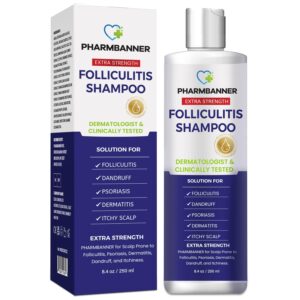
If your scalp acne feels itchy, red, or tender, this shampoo might be your best friend. It’s made for scalp conditions like folliculitis, seborrheic dermatitis, and dandruff — the kind that causes flare-ups and irritation.
The ingredients sound fancy, but what caught my attention were the herbal extracts. There’s Tea Tree Oil to fight bacteria, Panax Ginseng for scalp circulation, and Coptis Chinensis — a plant that’s known for its calming effect.
What I liked most is how soft it leaves the scalp after use. You just apply, massage it in for a few minutes, and rinse. The first time I tried it, I noticed less itching by the next day. It has a gentle, clean smell — not overwhelming.
People who’ve used it say the same: less dryness, fewer flakes, and that feeling of relief you get when your scalp finally stops burning. If your scalp acne is caused by fungus or inflammation, this one really helps reset things.
2. OGX Extra Strength Refreshing Scalp + Rosemary Oil Mint Dry Scalp Treatment
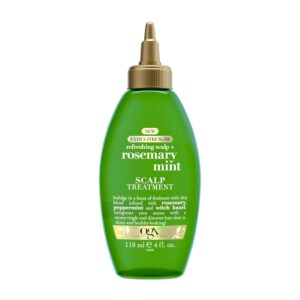
This one feels like a cooling breeze in a bottle. It’s a no-rinse treatment, which means you can apply it straight to damp hair after washing. The precision applicator makes it super easy — you just part your hair, squeeze a bit in, and massage.
It’s packed with Rosemary Oil, Peppermint Extract, and Witch Hazel. Together, they clear buildup and leave this refreshing tingle that feels almost like a mini scalp spa.
I like using this one when my scalp starts to feel greasy between washes. It absorbs fast and doesn’t make my hair oily. Plus, the scent — that minty, fresh smell — just makes everything feel cleaner.
One friend of mine swears by it for her seborrheic dermatitis. She says it’s the only thing that stops the itch without drying her scalp. For anyone who doesn’t want to wash too often, this treatment bridges the gap perfectly.
3. Roycederm Tea Tree Scalp Scrub
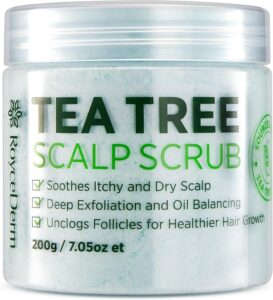
If you’ve never tried a scalp scrub before, this one’s a gentle way to start. It’s made with Tea Tree Oil, Witch Hazel, and Shea Butter — a mix that exfoliates without stripping.
When I used it for the first time, I was surprised by how light it felt. It forms this soft, creamy lather that lifts away dirt and flakes. The best part is how clean your scalp feels afterward — that “I can finally breathe” kind of clean.
This scrub is great before shampooing, especially when you’ve been using a lot of products. It helps unclog pores and makes your shampoo work better. Some people say it even helps their hair grow thicker because their follicles can finally breathe.
If you’ve ever had that waxy buildup near your roots, you’ll see the difference after one use. Just don’t overdo it — once or twice a week is perfect.
4. CLn® Shampoo
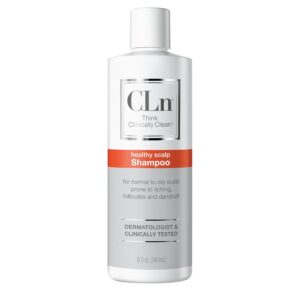
Developed by physicians, this shampoo means business. It’s not fancy-smelling or luxurious, but it works. It’s designed for oily scalps prone to folliculitis, dandruff, and itching.
What makes it special is its combination of Salicylic Acid and Sodium Hypochlorite — ingredients that clear clogged pores and reduce bacteria. I’d say it’s perfect if your scalp acne comes with a lot of oil buildup.
It doesn’t have any fragrance, dyes, or parabens, which I really appreciate. It’s strong enough to deep clean but gentle enough to use weekly.
The first time I used it, my scalp felt squeaky clean — maybe even too clean. I followed it up with a light conditioner, and that balanced it out perfectly. Some people find it drying, so if your scalp is on the sensitive side, start slow.
But if you’ve been dealing with persistent scalp breakouts and nothing helps, this shampoo is worth trying.
5. Ovante Acne Zap Shampoo
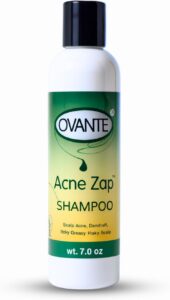
This one feels like it was made for people who’ve tried everything and just want results. It’s gentle on the skin but tough on acne. The mix of Sulfur, Tea Tree Oil, and Lemongrass Oil helps kill acne-causing bacteria while calming irritation.
It doesn’t smell great — let’s be honest — but that’s the trade-off for something this effective. I used it twice a week when I had a bad breakout, and it cleared things up noticeably within two weeks.
A lot of people say the same — it reduces scalp pimples by over 90% in some cases. You only need a small amount. Massage it in, leave it for a few minutes, rinse, and repeat if needed.
Once your scalp calms down, you can reduce how often you use it. It’s a little powerhouse for stubborn breakouts.
Building a Simple Scalp Care Routine
Now, let’s pull everything together. The best scalp acne treatment isn’t about using the most expensive products — it’s about consistency. Here’s a simple routine that keeps your scalp clear and happy:
- Start with a clean base. Use a medicated shampoo like Pharmbanner or CLn two or three times a week.
- Add exfoliation. Once or twice weekly, use the Roycederm Tea Tree Scalp Scrub before shampooing.
- Refresh between washes. Apply the OGX Rosemary Mint Treatment to soothe your scalp midweek.
- Don’t forget moisture. If your scalp feels dry, add a lightweight conditioner only to your ends.
Be patient. Healing takes time — usually a few weeks of consistent care.
There’s this quiet confidence that comes when your scalp finally feels balanced. You notice it when brushing your hair or resting your head without discomfort. It’s such a small relief, but it changes how you feel.
Your scalp will tell you what it needs — you just have to listen.
Check Out: Scalp Detoxification Methods: The Secret to a Fresh, Healthy Scalp
When to See a Dermatologist
If your scalp acne doesn’t improve after a few weeks of care, it might be time to get medical advice. Some signs that mean it’s time to see a dermatologist:
- Painful, swollen bumps that don’t go away.
- Pus-filled or cyst-like acne.
- Hair thinning or bald patches around breakouts.
- Persistent itching, burning, or flaking.
Sometimes scalp acne is linked to conditions like psoriasis or seborrheic dermatitis, and you’ll need prescription-strength treatment. The key is not to wait until it gets worse. Getting help early prevents scarring or hair loss later.
Conclusion
Your scalp deserves the same care you give your skin. Scalp acne isn’t a sign of poor hygiene — it’s your body asking for balance.
Once I started treating my scalp with patience instead of frustration, everything changed. The itching stopped, the bumps faded, and my hair felt lighter than ever. You can have that too.
Take your time. Choose the products that suit your scalp best. Stick to a simple, steady routine. And soon, your scalp will thank you — quietly, through that clean, healthy feeling you can actually feel when you run your fingers through your hair.
Frequently Asked Questions
Can I use scalp acne shampoo daily?
It depends on how sensitive your scalp is. For most people, two to three times a week is enough. Using it daily might dry out your scalp unless the product label says it’s safe for everyday use.
Will scalp acne cause hair loss?
Only if left untreated. Inflammation from acne can weaken hair follicles, but once the scalp heals, hair growth usually returns to normal.
Is tea tree oil good for scalp acne?
Yes, tea tree oil has antibacterial properties that help reduce acne and soothe irritation. Just make sure the concentration isn’t too strong — diluted or product-based forms are safest.
Can diet or stress trigger scalp acne?
Absolutely. Hormonal changes, stress, and even too much sugar or dairy can contribute to breakouts. Try to balance your diet and manage stress levels — it helps your scalp and your skin.

